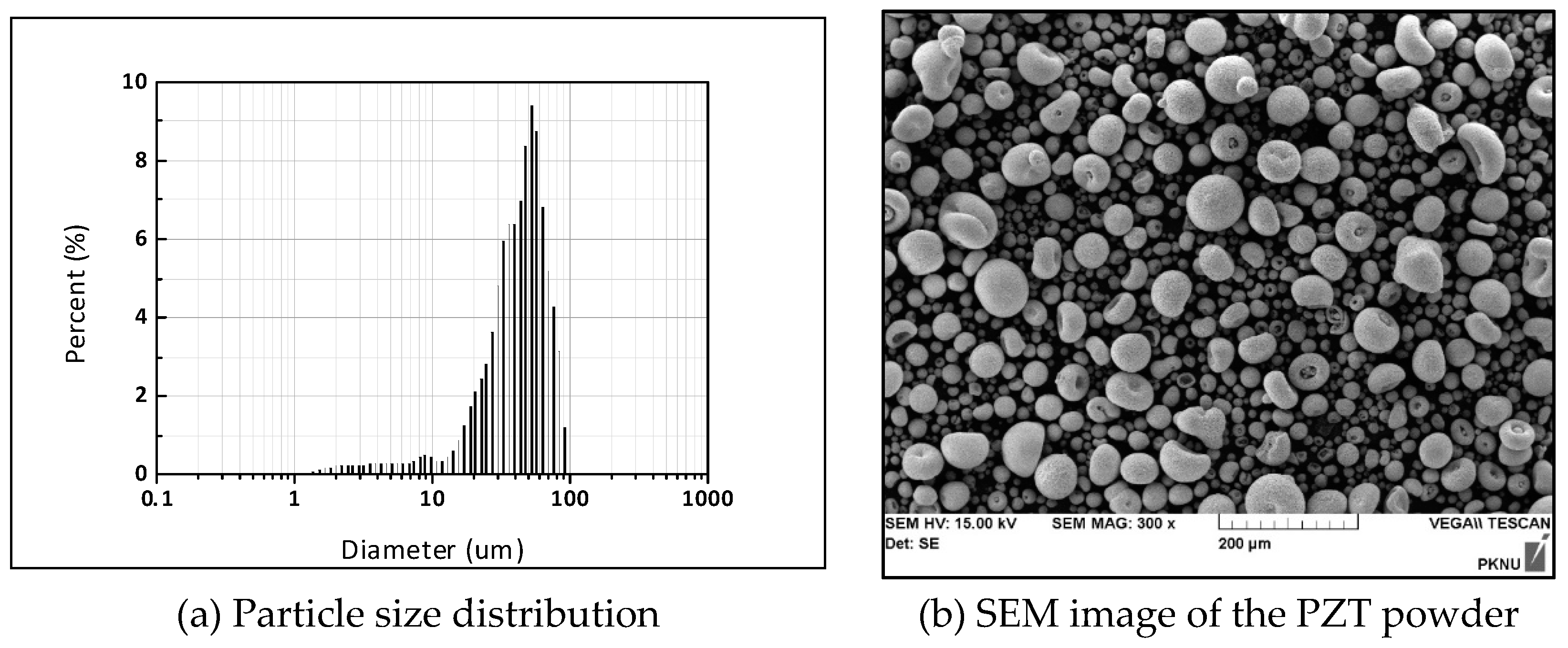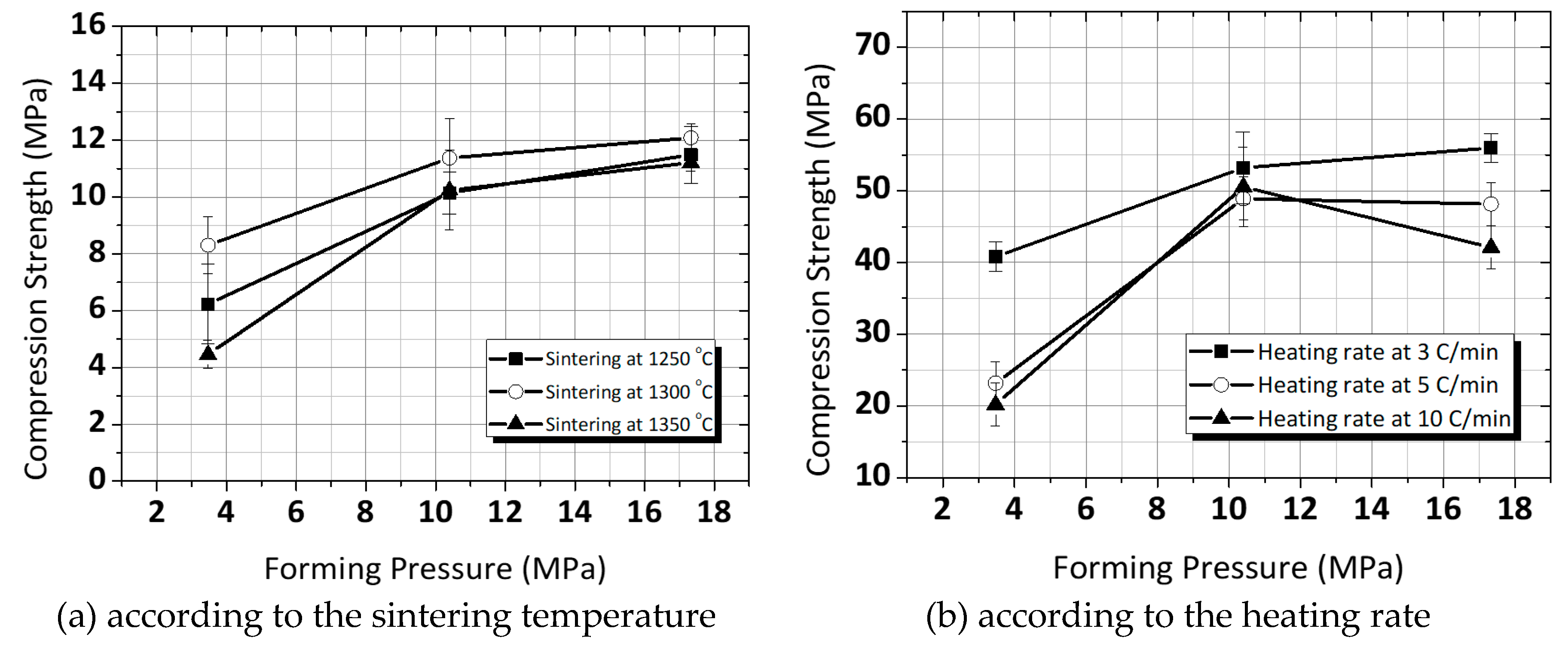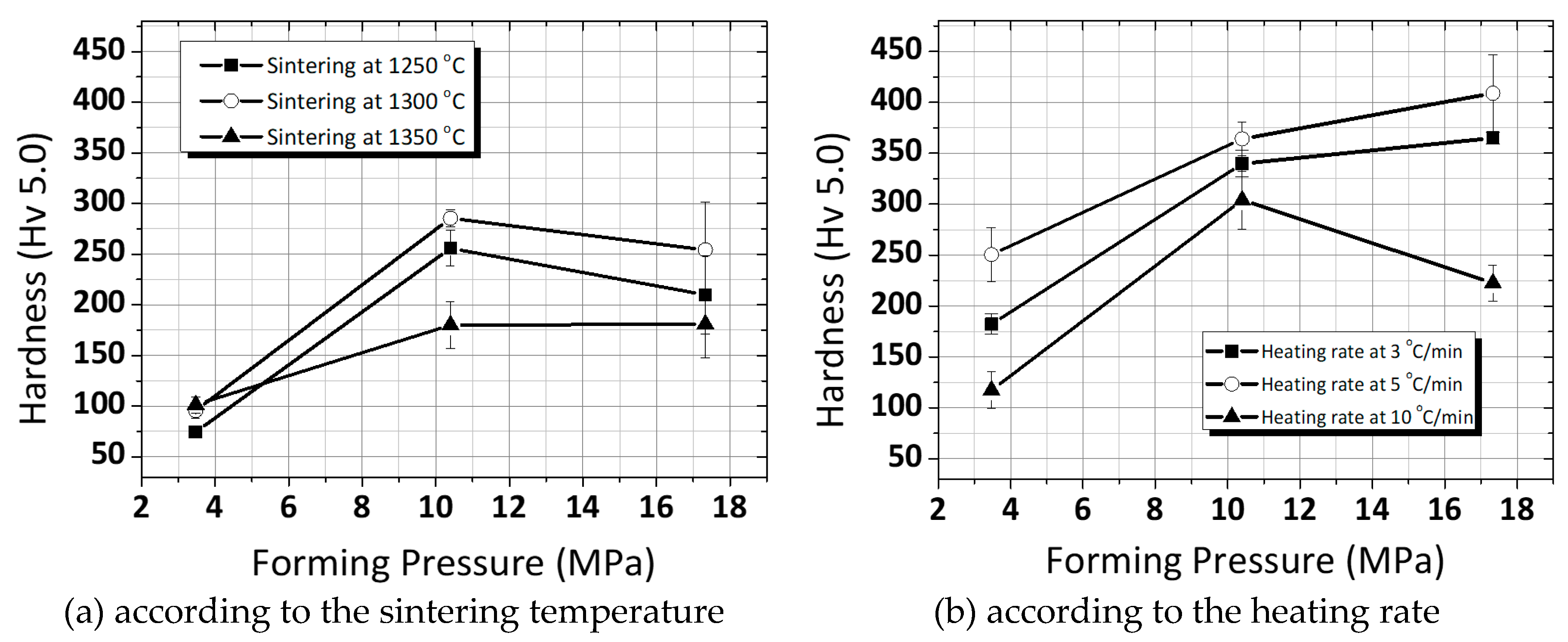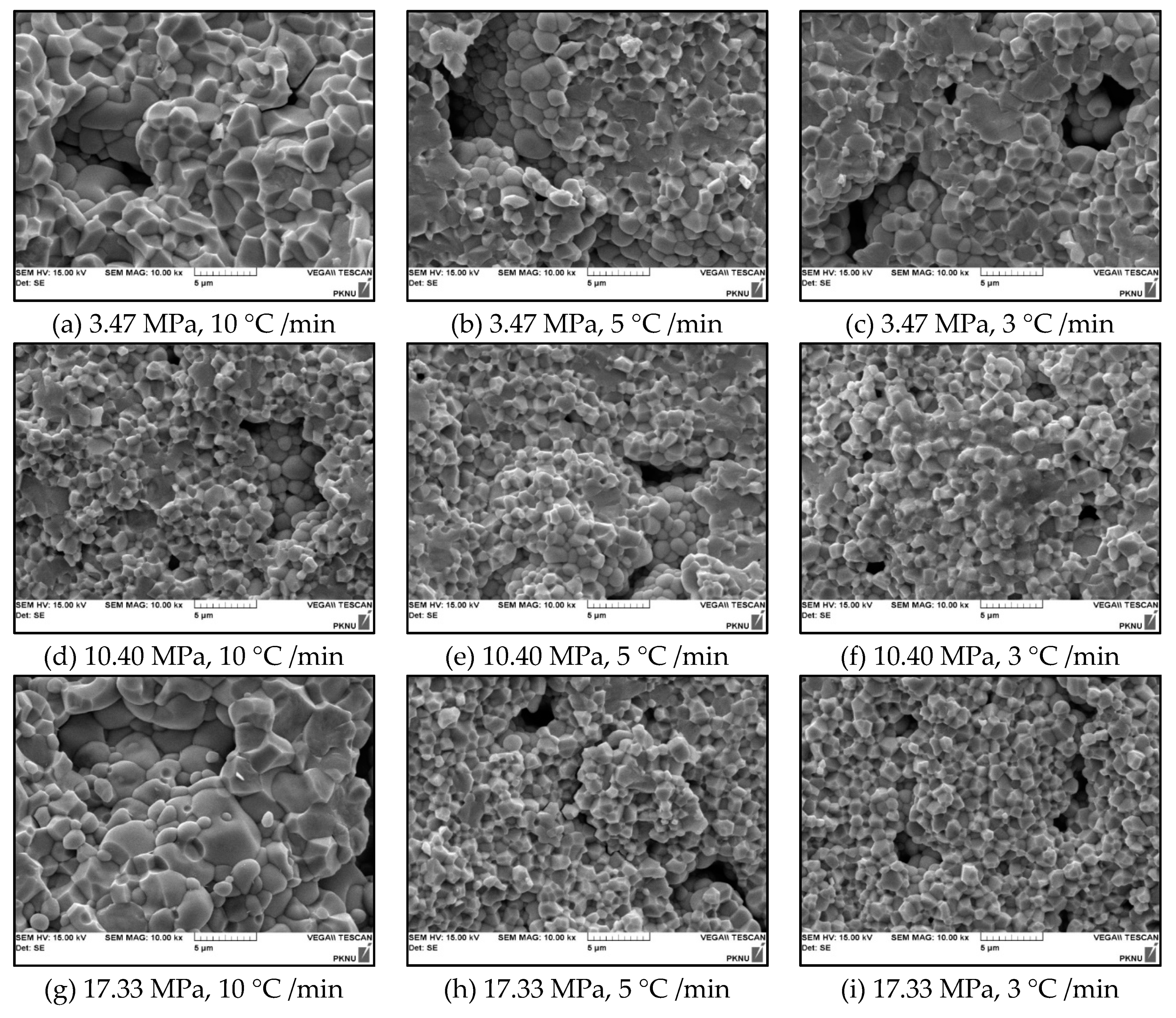Performance Improvement of Ring-Type PZT Ceramics for Ultrasonic Dispersion System
Abstract
:1. Introduction
2. Materials and Methods
2.1. Materials
2.2. Sample Preparation and Characterization Methods
2.3. Polarization and Dielectric Property
3. Results and Discussion
3.1. Density of the Fabricated Lead Zirconate Titanate (PZT) Ceramics
3.2. Structural Analysis
3.3. Mechanical Property of the Ring-Type PZT Ceramics
3.4. Dielectric Property Analysis
3.5. Microstructural and Morphology Analysis
4. Conclusions
Author Contributions
Funding
Conflicts of Interest
References
- Jaffe, B.; Roth, R.S.; Marzullo, S. Properties of piezoelectric ceramics in the solid-solution series lead titanate-lead zirconate-lead oxide: Tin oxide and lead titanate-lead hafnate. J. Res. Natl. Bur. Stand. 1955, 55, 239–254. [Google Scholar] [CrossRef]
- Chen, J.; Qiu, Q.; Han, Y.; Lau, D. Piezoelectric materials for sustainable building structures: Fundamentals and applications. Renew. Sustain. Energy Rev. 2019, 101, 14–25. [Google Scholar] [CrossRef]
- Sumitomo, S.; Koizumi, H.; Uddin, M.A.; Kato, Y. Comparison of dispersion behavior of agglomerated particles in liquid between ultrasonic irradiation and mechanical stirring. J. Ultrason. Sonochem. 2018, 40, 822–831. [Google Scholar] [CrossRef] [PubMed]
- Khokhlova, T.D.; Hwang, J.H. HIFU for palliative treatment of pancreatic cancer. J. Gastrointest. Oncol. 2011, 2, 175–184. [Google Scholar] [PubMed]
- Prasatkhetragarn, A.; Yimnirun, R. Phase formation, electrical properties and morphotropic phase boundary of 0.95Pb(ZrxTi1-x)O3–0.05Pb(Mn1/3Nb2/3)O3 ceramics. J. Ceram. Int. 2013, 39, 91–95. [Google Scholar] [CrossRef]
- Puchmark, C.; Rujijanagul, G.; Jiansirisomboon, S.; Tunkasiri, T.; Vittayakorn, N.; Comyn, T.; Milne, S.J. Mechanical property evaluation of PZT/Al2O3 composites prepared by a simple solid-state mixed oxide method. J. Curr. Appl. Phys. 2006, 6, 323–326. [Google Scholar] [CrossRef]
- Gabilondo, M.; Fraile, I.; Burgos, N.; Azcona, M.; Castro, F. Microstructural comparison between precursor-based and particle-based PZT ceramic coatings. J. Ceram. Int. 2019, 45, 23149–23156. [Google Scholar] [CrossRef]
- Ma, H.J.; Jung, W.K.; Baek, C.; Kim, D.K. Influence of micro-structure control on optical and mechanical properties of infrared transparent Y2O3-MgO nanocomposite. J. Eur. Ceram. Soc. 2017, 37, 4902–4911. [Google Scholar] [CrossRef]
- Xie, J.; Mao, X.; Li, X.; Jiang, B.; Zhang, L. Influence of moisture absorption on the synthesis and properties of Y2O3–MgO nanocomposites. J. Ceram. Int. 2017, 43, 40–44. [Google Scholar] [CrossRef]
- Ryu, J.; Choi., J.J.; Kim, H.E. Effect of Heating Rate on the Sintering Behavior and the Piezoelectric Properties of Lead Zirconate Titanate Ceramics. J. Am. Ceram. Soc. 2001, 84, 902–904. [Google Scholar] [CrossRef]
- Han, J.S.; Gal, C.W.; Park., J.M.; Park, S.J. Powder injection molding of PNN-PMN-PZN doped low temperature sintering PZT ceramics. J. Manuf. Process. 2017, 28, 235–242. [Google Scholar] [CrossRef]
- Limpichaipanit, A.; Somwan, S.; Ngamjarurojana, A. Dielectric properties of PFN–PZT composites: From relaxor to normal ferroelectric behavior. J. Ceram. Int. 2018, 44, 14797–14802. [Google Scholar] [CrossRef]
- Sheinerman, A.G.; Castro, R.H.; Gutkin, M.Y. A model for firect and inverse Hall-Petch relation for nanocrystalline ceramics. J. Mater. Lett. 2020, 260, 126886. [Google Scholar] [CrossRef]
- Sokol, M.; Kalabukhov, S.; Shneck, R.; Zaretsky, E.; Frage, N. Effect of grain size on the static and dynamic mechanical properties of magnesium aluminate spinel (MgAl2O4). J. Eur. Ceram. Soc. 2017, 37, 3417–3424. [Google Scholar] [CrossRef]
- Sokol, M.; Halabi, M.; Kalabukhov, S.; Frage, N. Nano-structured MgAl2O4 spinel consolidated by high pressure spark plasma sintering (HPSPS). J. Eur. Ceram. Soc. 2017, 37, 755–762. [Google Scholar] [CrossRef]
- Wollmershauser, J.A.; Feigelson, B.N.; Gorzkowski, E.P.; Ellis, C.T.; Goswami, R.; Qadri, S.B.; Tischler, J.G.; Kub, F.J.; Everett, R.K. An extended hardness limit in bulk nanoceramics. J. Acta Mater. 2014, 69, 9–16. [Google Scholar] [CrossRef]
- Schiøtz, J.; Vegge, T.; Di Tolla, F.D.; Jacobsen, K.W. Atomic-scale simulations of the mechanical deformation of nanocrystalline metals. J. Phys. Rev. B-Condens. Matter Mater. Phys. 1999, 60, 11971–11983. [Google Scholar]
- Venkatraman, R.; Bravman, J.C. Separation of film thickness and grain boundary strengthening effects in Al thin films on Si. J. Mater. Res. 1992, 7, 2040–2048. [Google Scholar] [CrossRef]
- Conrad, H. Grain size dependence of the plastic deformation kinetics in Cu. J. Mater. Sci. Eng. A 2003, 341, 216–228. [Google Scholar] [CrossRef]
- Wen, H.; Wang, X.; Li, L. Mechanical properties of sol-gel derived BiScO3–PbTiO3 thin films by nanoindentation. J. Appl. Phys. 2006, 100, 084315. [Google Scholar] [CrossRef]
- Babu, T.A.; Ramesh, K.V.; Reddy, V.R.; Sastry, D.L. Structural and dielectric studies of excessive Bi3+ containing perovskite PZT and pyrochlore biphasic ceramics. J. Mater. Sci. Eng. B 2018, 228, 175–182. [Google Scholar] [CrossRef]
- Fang, B.; Shan, Y.; Imoto, H. Charge Compensation Mechanism Decreases Dielectric Loss in Manganese-Doped Pb(Fe1/2Nb1/2)O3 Ceramics. Jpn. J. Appl. Phys. 2004, 43, 2568–2571. [Google Scholar] [CrossRef]
- Kang, D.H.; Yoon, K.H. Dielectric properties due to excess PbO and MgO in lead magnesium niobate ceramics. J. Ferroelectr. 1988, 87, 255–264. [Google Scholar] [CrossRef]
- Safronova, N.A.; Kryzhanovska, O.S.; Dobrotvorska, M.V.; Balabanov, A.E.; Tolmachev, А.V.; Yavetskiy, R.P.; Parkhomenko, S.V.; Brodskii, R.Y.; Baumer, V.N.; Kosyanov, D.Y.; et al. Influence of sintering temperature on structural and optical properties of Y2O3–MgO composite SPS ceramics. J. Ceram. Int. 2019. [Google Scholar] [CrossRef]
- Zaghete, M.A.; Varela, J.A.; Cilense, M.; Paiva-Santos, C.O.; Las, W.C.; Longo, E. The effect of isostructural seeding on the microstructure and piezoelectric properties of PZT ceramics. J. Ceram. Int. 1999, 25, 239–244. [Google Scholar] [CrossRef]







| Element | Weight (%) | Atomic (%) |
|---|---|---|
| O | 20.04 | 69.10 |
| Ti | 06.62 | 07.61 |
| Zr | 10.59 | 06.40 |
| Sn | 00.97 | 00.45 |
| Pb | 61.78 | 16.44 |
| Total | 100 | |
| Forming Pressure (MPa) | Sintering Temperature (°C) | Heating Rate (°C/min) | Relative Density (%) |
|---|---|---|---|
| 3.47 | 1250 | 10 | 90.33 |
| 3.47 | 1300 | 10 | 90.28 |
| 3.47 | 1350 | 10 | 88.39 |
| 3.47 | 1300 | 5 | 94.07 |
| 3.47 | 1300 | 3 | 96.25 |
| 10.40 | 1250 | 10 | 95.95 |
| 10.40 | 1300 | 10 | 95.40 |
| 10.40 | 1350 | 10 | 94.39 |
| 10.40 | 1300 | 5 | 97.38 |
| 10.40 | 1300 | 3 | 99.78 |
| 17.33 | 1250 | 10 | 96.55 |
| 17.33 | 1300 | 10 | 96.54 |
| 17.33 | 1350 | 10 | 92.08 |
| 17.33 | 1300 | 5 | 99.99 |
| 17.33 | 1300 | 3 | 99.99 |
| Forming Pressure (MPa) | Heating Rate (°C/min) | Capacitance (nF) | Relative Dielectric Constant (εr) |
|---|---|---|---|
| 10.40 | 10 | 6.18 | 2124 |
| 10.40 | 5 | 6.28 | 2204 |
| 10.40 | 3 | 5.71 | 2130 |
| 17.33 | 10 | 6.46 | 2078 |
| 17.33 | 5 | 5.69 | 2197 |
| 17.33 | 3 | 5.49 | 2082 |
© 2020 by the authors. Licensee MDPI, Basel, Switzerland. This article is an open access article distributed under the terms and conditions of the Creative Commons Attribution (CC BY) license (http://creativecommons.org/licenses/by/4.0/).
Share and Cite
Choi, Y.M.; Lee, Y.L.; Lim, E.S.; Trimzi, M.A.; Hwangbo, S.A.; Ham, Y.B. Performance Improvement of Ring-Type PZT Ceramics for Ultrasonic Dispersion System. Micromachines 2020, 11, 144. https://doi.org/10.3390/mi11020144
Choi YM, Lee YL, Lim ES, Trimzi MA, Hwangbo SA, Ham YB. Performance Improvement of Ring-Type PZT Ceramics for Ultrasonic Dispersion System. Micromachines. 2020; 11(2):144. https://doi.org/10.3390/mi11020144
Chicago/Turabian StyleChoi, Young Min, Yang Lae Lee, Eui Su Lim, Mojiz Abbas Trimzi, Seon Ae Hwangbo, and Young Bog Ham. 2020. "Performance Improvement of Ring-Type PZT Ceramics for Ultrasonic Dispersion System" Micromachines 11, no. 2: 144. https://doi.org/10.3390/mi11020144
APA StyleChoi, Y. M., Lee, Y. L., Lim, E. S., Trimzi, M. A., Hwangbo, S. A., & Ham, Y. B. (2020). Performance Improvement of Ring-Type PZT Ceramics for Ultrasonic Dispersion System. Micromachines, 11(2), 144. https://doi.org/10.3390/mi11020144






